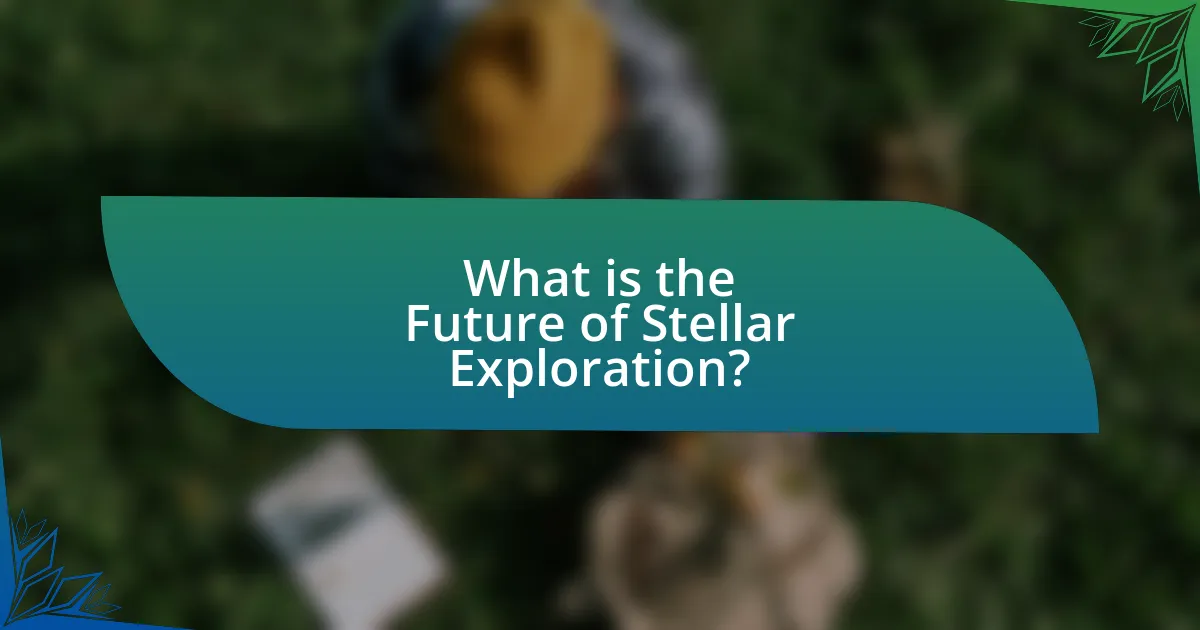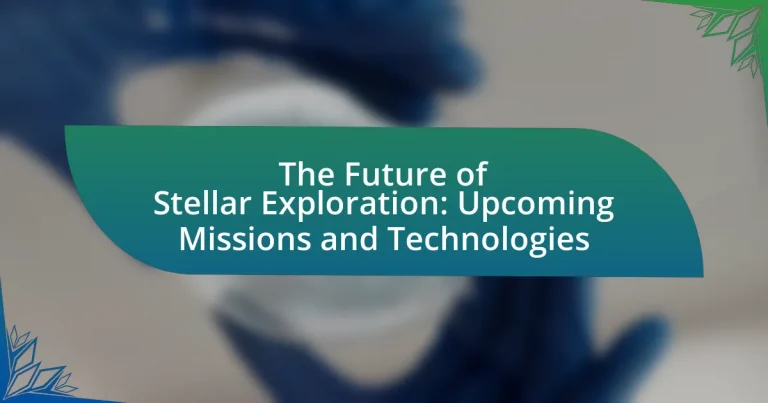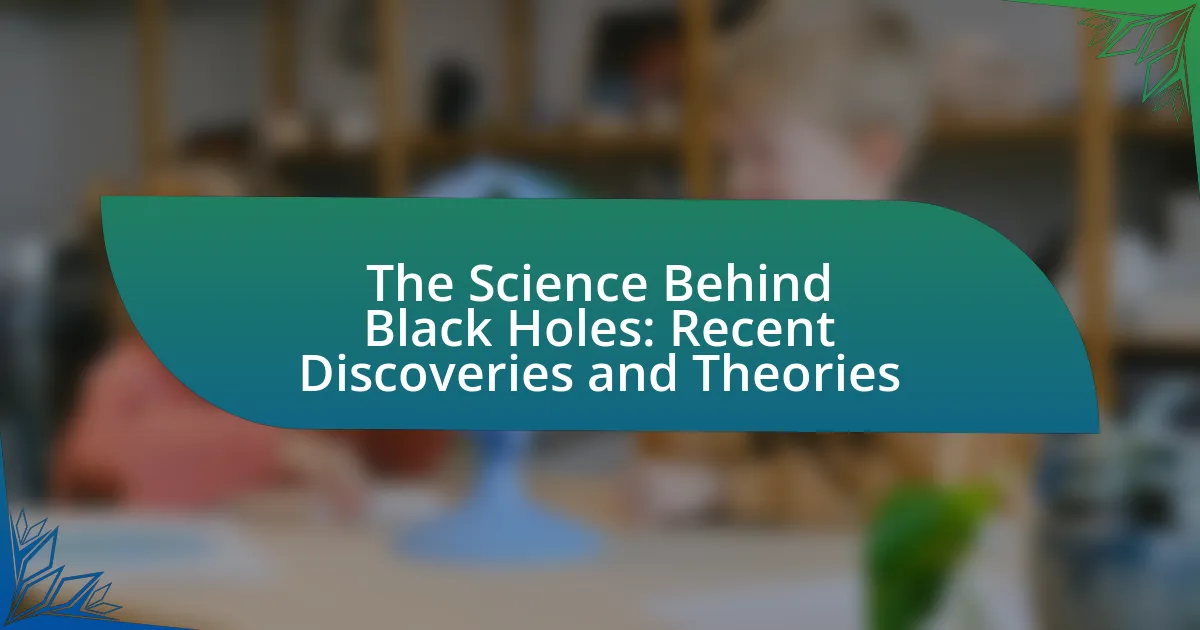The article focuses on the future of stellar exploration, highlighting upcoming missions and advanced technologies aimed at understanding distant stars and their systems. Key projects such as the James Webb Space Telescope and the European Space Agency’s PLATO mission are set to enhance our knowledge of exoplanets, stellar formation, and cosmic phenomena. The article also discusses the objectives of these missions, the role of international collaborations, and the technological advancements necessary for successful exploration. Additionally, it addresses the challenges faced by upcoming missions, including budget constraints and technological hurdles, while emphasizing the importance of public support for future space exploration initiatives.

What is the Future of Stellar Exploration?
The future of stellar exploration involves advanced missions and technologies aimed at understanding distant stars and their systems. Upcoming projects, such as the James Webb Space Telescope and the European Space Agency’s PLATO mission, are designed to study exoplanets and stellar phenomena in unprecedented detail. These missions will utilize cutting-edge instruments to gather data on star formation, stellar evolution, and the potential for life in other solar systems, enhancing our knowledge of the universe. The integration of artificial intelligence in data analysis will further accelerate discoveries, making stellar exploration more efficient and insightful.
How is stellar exploration defined in the context of future missions?
Stellar exploration in the context of future missions is defined as the scientific investigation and study of stars beyond our solar system, utilizing advanced technologies and spacecraft designed for interstellar travel. This definition encompasses missions aimed at gathering data on stellar characteristics, compositions, and potential exoplanets, with notable examples including the proposed Breakthrough Starshot initiative, which seeks to send lightweight probes to the Alpha Centauri system within a generation. These missions are driven by the need to expand our understanding of the universe and the potential for life beyond Earth, supported by advancements in propulsion systems and astronomical instruments that enhance our capability to explore distant stars.
What are the key objectives of upcoming stellar exploration missions?
The key objectives of upcoming stellar exploration missions include the search for exoplanets, the study of stellar formation and evolution, and the investigation of cosmic phenomena such as black holes and neutron stars. These missions aim to enhance our understanding of the universe’s structure and origins. For instance, NASA’s James Webb Space Telescope, launched in December 2021, is designed to observe the formation of stars and galaxies, providing insights into the early universe. Additionally, missions like the European Space Agency’s PLATO (PLAnetary Transits and Oscillations of stars) aim to identify and characterize Earth-like exoplanets in habitable zones around stars, contributing to the search for extraterrestrial life.
How does stellar exploration differ from other forms of space exploration?
Stellar exploration differs from other forms of space exploration primarily in its focus on studying stars and their systems beyond our solar system. While traditional space exploration often concentrates on planetary bodies, moons, and asteroids within our solar system, stellar exploration aims to understand the formation, evolution, and characteristics of stars, as well as the potential for habitable exoplanets in their vicinity. For instance, missions like the Kepler Space Telescope have specifically targeted exoplanets orbiting distant stars, providing insights into their atmospheres and potential for life, which is distinct from missions like Mars rovers that focus on geological and biological studies of a single planet.
Why is the future of stellar exploration important?
The future of stellar exploration is important because it holds the potential to expand our understanding of the universe, including the origins of stars, planets, and possibly life beyond Earth. Advancements in technology, such as the development of more powerful telescopes and spacecraft, enable scientists to gather data from distant celestial bodies, which can lead to groundbreaking discoveries. For instance, missions like the James Webb Space Telescope are designed to observe the atmospheres of exoplanets, providing insights into their habitability. This exploration not only enhances our scientific knowledge but also inspires innovation and collaboration in various fields, including engineering and environmental science.
What scientific advancements can be achieved through stellar exploration?
Stellar exploration can achieve significant scientific advancements, including enhanced understanding of stellar formation, evolution, and the potential for extraterrestrial life. By studying stars and their systems, researchers can gather data on the chemical composition and physical properties of celestial bodies, which informs theories about the origins of the universe. For instance, missions like the James Webb Space Telescope aim to observe distant stars and galaxies, providing insights into the early universe and the lifecycle of stars. Additionally, advancements in technology, such as improved telescopes and spacecraft, facilitate the detection of exoplanets and their atmospheres, which is crucial for assessing habitability and the presence of life beyond Earth.
How does stellar exploration contribute to our understanding of the universe?
Stellar exploration enhances our understanding of the universe by providing critical data about the formation, evolution, and composition of celestial bodies. Through missions like the Hubble Space Telescope and the upcoming James Webb Space Telescope, scientists gather information on star formation processes, the lifecycle of stars, and the presence of exoplanets. For instance, Hubble has contributed to the discovery of thousands of exoplanets and has provided insights into the age and chemical makeup of stars, which are essential for understanding the universe’s history and structure. This data allows researchers to test theories of cosmic evolution and refine models of the universe’s expansion, thereby deepening our comprehension of fundamental astrophysical principles.

What upcoming missions are planned for stellar exploration?
NASA’s upcoming missions for stellar exploration include the James Webb Space Telescope (JWST), which is set to observe distant stars and galaxies, and the European Space Agency’s (ESA) Euclid mission, aimed at studying dark energy and dark matter through galaxy surveys. JWST, launched in December 2021, will provide unprecedented infrared observations, allowing scientists to analyze the formation and evolution of stars. Euclid, scheduled for launch in 2024, will map the geometry of the dark universe, enhancing our understanding of stellar formation and distribution. These missions are pivotal in advancing our knowledge of the cosmos and the fundamental processes governing stellar phenomena.
Which organizations are leading the charge in upcoming stellar missions?
NASA, the European Space Agency (ESA), and SpaceX are leading the charge in upcoming stellar missions. NASA is planning the Artemis program to return humans to the Moon and eventually send astronauts to Mars, with missions like the Mars Sample Return and the James Webb Space Telescope enhancing our understanding of the universe. ESA is developing the Jupiter Icy Moons Explorer (JUICE) to study Jupiter’s moons, while SpaceX is advancing its Starship program for deep space exploration, including missions to Mars. These organizations are at the forefront of space exploration, driving innovation and expanding our reach into the cosmos.
What are the notable missions scheduled for the next decade?
Notable missions scheduled for the next decade include NASA’s Artemis program, which aims to return humans to the Moon by 2024 and establish a sustainable presence by 2028. Additionally, the European Space Agency’s Jupiter Icy Moons Explorer (JUICE) is set to launch in 2023 to study Jupiter’s moons, with arrival expected in 2031. NASA’s Mars Sample Return mission is also planned for the late 2020s, aiming to bring samples from Mars back to Earth. These missions are significant as they represent advancements in human space exploration and planetary science, with specific timelines and objectives outlined by their respective space agencies.
How do international collaborations enhance stellar exploration efforts?
International collaborations enhance stellar exploration efforts by pooling resources, expertise, and technology from multiple countries, which accelerates research and development. For instance, the International Space Station (ISS) exemplifies how collaborative projects can lead to significant advancements in space science, as it involves contributions from NASA, ESA, Roscosmos, JAXA, and CSA. This partnership allows for shared funding, diverse scientific perspectives, and access to a broader range of technologies, ultimately leading to more ambitious missions, such as the Artemis program, which aims to return humans to the Moon and eventually explore Mars. Such collaborations not only increase the scientific output but also foster diplomatic relations and inspire global interest in space exploration.
What technologies are being developed for future stellar missions?
Technologies being developed for future stellar missions include advanced propulsion systems, autonomous navigation, and in-situ resource utilization. Advanced propulsion systems, such as solar sails and ion thrusters, aim to significantly reduce travel time to distant stars. Autonomous navigation technologies are being designed to allow spacecraft to make real-time decisions without human intervention, enhancing mission efficiency. In-situ resource utilization focuses on using local materials for fuel and life support, which is crucial for long-duration missions. These developments are supported by ongoing research and testing, such as NASA’s Innovative Advanced Concepts program, which explores novel propulsion methods and mission architectures.
What role do propulsion systems play in upcoming missions?
Propulsion systems are critical for upcoming missions as they determine the speed, trajectory, and efficiency of spacecraft. These systems enable vehicles to escape Earth’s gravity, navigate through space, and perform maneuvers essential for mission objectives. For instance, advancements in propulsion technologies, such as ion propulsion and solar sails, allow for longer missions with reduced fuel consumption, enhancing the feasibility of deep-space exploration. Historical examples, like NASA’s Dawn spacecraft, which utilized ion propulsion to reach and study the asteroid belt, demonstrate the effectiveness of these systems in achieving complex mission goals.
How are advancements in robotics shaping stellar exploration?
Advancements in robotics are significantly enhancing stellar exploration by enabling autonomous operations, improving data collection, and facilitating remote analysis of celestial bodies. For instance, robotic spacecraft like NASA’s Perseverance rover utilize advanced AI and machine learning algorithms to navigate and conduct experiments on Mars without real-time human intervention. This autonomy allows for more efficient exploration of distant planets and moons, as seen in missions like the Mars 2020 mission, which has successfully collected and analyzed rock samples. Furthermore, robotic systems are being developed for future missions to the outer planets, such as Europa Clipper, which will employ sophisticated robotic instruments to study the icy moon’s potential for life. These advancements not only increase the scope and depth of exploration but also reduce the risks and costs associated with human spaceflight.

How will upcoming missions impact our understanding of the cosmos?
Upcoming missions will significantly enhance our understanding of the cosmos by providing new data on celestial phenomena and expanding our knowledge of the universe’s structure and origins. For instance, the James Webb Space Telescope, launched in December 2021, is already revealing insights into the formation of stars and galaxies, allowing scientists to observe the universe’s earliest epochs. Additionally, missions like the European Space Agency’s Euclid, set to launch in 2023, aim to map dark matter and dark energy, which together constitute about 95% of the universe’s total mass-energy content. These missions will not only refine existing theories but also potentially lead to groundbreaking discoveries that challenge our current understanding of fundamental astrophysical processes.
What discoveries are anticipated from future stellar exploration missions?
Future stellar exploration missions are anticipated to yield discoveries related to exoplanets, stellar formation, and cosmic phenomena. These missions aim to identify potentially habitable exoplanets by analyzing their atmospheres for biosignatures, which could indicate the presence of life. Additionally, advancements in technology will enhance our understanding of stellar evolution and the lifecycle of stars, providing insights into the formation of galaxies. For instance, the James Webb Space Telescope is expected to contribute significantly to these discoveries by capturing detailed images and spectra of distant celestial bodies, thereby expanding our knowledge of the universe.
How might these discoveries change our view of life beyond Earth?
Discoveries in stellar exploration may significantly broaden our understanding of life beyond Earth by revealing the potential for diverse biospheres in previously unconsidered environments. For instance, the detection of exoplanets in habitable zones, as demonstrated by missions like Kepler and TESS, suggests that conditions suitable for life may be more common than previously thought. Additionally, the identification of extremophiles on Earth, which thrive in harsh conditions, supports the idea that life could exist in extreme environments elsewhere in the universe, such as on icy moons like Europa or Enceladus. These findings challenge the traditional view that life requires Earth-like conditions, thus expanding the criteria for habitability and guiding future missions to explore a wider range of celestial bodies.
What implications do these missions have for future space travel?
These missions significantly advance future space travel by enhancing our understanding of deep space environments and developing new technologies for exploration. For instance, missions like the James Webb Space Telescope are expected to provide insights into the atmospheres of exoplanets, which could inform the design of future spacecraft and habitats. Additionally, advancements in propulsion systems, such as those being tested in the Artemis program, aim to reduce travel time to distant destinations, making human exploration of Mars and beyond more feasible. Historical data from previous missions, such as the Mars rovers, have already demonstrated the importance of in-situ resource utilization, which will be critical for sustaining long-term human presence in space.
What challenges do upcoming missions face?
Upcoming missions face significant challenges including funding constraints, technological limitations, and environmental hazards. Funding constraints often lead to reduced mission scopes or delays, as seen in NASA’s Mars missions where budget cuts impacted timelines. Technological limitations can hinder the development of necessary instruments for data collection and analysis, exemplified by the difficulties faced in creating reliable propulsion systems for deep space travel. Environmental hazards, such as radiation exposure and micrometeoroid impacts, pose risks to spacecraft and instruments, as highlighted by the challenges encountered during the Parker Solar Probe’s mission. These factors collectively complicate the planning and execution of future stellar exploration missions.
How do budget constraints affect mission planning and execution?
Budget constraints significantly limit the scope and resources available for mission planning and execution in stellar exploration. These financial limitations force mission planners to prioritize objectives, often resulting in reduced scientific goals, fewer instruments, or smaller spacecraft. For instance, NASA’s budget cuts in the early 2010s led to the cancellation of several proposed missions, such as the Jupiter Europa Orbiter, which would have provided critical data on potential habitability. Consequently, budget constraints can delay timelines, reduce the number of missions launched, and ultimately impact the advancement of knowledge in the field of space exploration.
What technological hurdles must be overcome for successful missions?
Successful missions in stellar exploration must overcome technological hurdles such as propulsion efficiency, communication delays, and life support systems. Propulsion efficiency is critical, as current chemical propulsion limits the speed and distance of spacecraft; advancements in ion propulsion and nuclear thermal propulsion are necessary to enable faster travel to distant stars. Communication delays pose challenges due to the vast distances involved, requiring the development of more advanced relay systems or quantum communication technologies to maintain contact with missions. Additionally, life support systems must be enhanced to sustain human crews for extended periods, necessitating breakthroughs in closed-loop life support and radiation protection technologies. These hurdles are essential to address for the feasibility and success of future missions beyond our solar system.
What can individuals do to support the future of stellar exploration?
Individuals can support the future of stellar exploration by advocating for increased funding and public interest in space research. Engaging with local and national representatives to promote policies that prioritize space exploration can lead to more resources allocated to missions. Additionally, individuals can participate in educational programs and outreach initiatives that raise awareness about the importance of space science. For instance, NASA’s Artemis program aims to return humans to the Moon and eventually send astronauts to Mars, highlighting the need for public support and understanding of these missions. By fostering a culture of curiosity and investment in STEM education, individuals contribute to a future where stellar exploration is prioritized and advanced.




